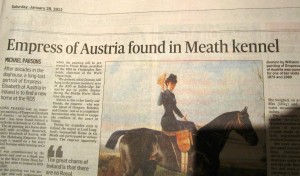Headline in the Irish Times that caught my eye.
Category Archives: Asides
Breakfast 2012-04-08!
Brassai on Henry Miller
The Hungarian photographer, Brassai (whose real name was Gyula Halász), is one of my favourite artists (and a huge print of one of his most celebrated photographs — Les Escaliers de Montmartre — hangs in our dining room). But I had no idea he could write — until I stumbled on his book, Henry Miller: The Paris Years. It’s a startlingly illuminating and well-written book about a writer who was one of the photographer’s closest friends in Paris in the inter-war years, and who — until now — has always been an enigma to me.
Here’s how it opens:
“How does your memory of this compare with yours? I seem to see you standing in the Gutter at the Dome, a l’angle de la rue Delambre et Blvd Montparnasse… You had a newspaper in your hand. You told us you have begun to practice photography. It may have been the year 1931. The spot where you stood I see so vividly that I could draw a circle around it.” In a letter to me, this is how Henry Miller recalled our first meeting. “It’s strange”, he told me, “but with most people we remember neither where nor under shat circumstances we met. But I remember the first time you and I met as if it were yesterday.”
My memory doesn’t quite compare with his. My memory of the first time Henry and I met was that it took place in December 1930, shortly after he had arrived in France. My friend the painter Louis Tihanyi introduced us. Louis was sort of the Dome’s PR man — everyone recognised his olive green corduroy overcoat, worn to a shine, his wide-brimmed gray felt hat, his monocle, his fleshy lower lip. He was the spitting image of Alphonse XIII — minus the pencil mustache. Every night, table by table, Louis worked the crowded Dome terrace, which, beneath the luminous green shade of the trees on the boulevard, was always festive, as if every day were Bastille. Although deaf, and very nearly dumb as well, Louis was the best-informed man in Montparnasse. He knew not only every single one of the regulars, but the measure and worth of each newcomer.
“I want you to meet Henry Miller, an American writer,” he announced in his abrupt, guttural voice, which somehow always managed to make itself heard over the hum of conversation and the noise from the street”.
And there was Henry Miller. I will never forget the first sight of his rosy face emerging from a rumpled raincoat: the pouting, full lower lip, eyes the color of the sea. His eyes were like those of a sailor skilled at scanning the horizons through the spray. They always conveyed calmness and serenity, those eyes, and even though their expression seemed as guileless and attentive as a dog’s, they lay in ambush behind large tortoiseshell glasses…”.
I couldn’t put it down. It’s a fascinating blend of insight, affection, forgiveness and acuity. And, like Hemingway’s A Moveable Feast and Woody Allen’s Midnight in Paris
, it’s beautifully evocative of an astonishing period in the life of my favourite city.
I want to be alone: Colm Toibín on solo living
From the Guardian.
On Saturday I wake at six and relishing the day ahead. I teach on Mondays and Tuesdays; I have to reread a novel for each class and take notes on it. Nothing makes me happier than the thought of this. I often lie there until the seven o’clock news comes on, grinning at the thought of the day ahead.
All day I will read and take notes. The worst-case scenario is that I might need another book, and this involves lot of decision-making and self-consultation. It might end in a five-minute walk to the university library. But normally I go nowhere except to the fridge if I am hungry to see what’s there, or to the sofa to lie down if my back is tired, or to the rocking chair if I feel a need to rock.
Normally there’s not much in the fridge. In the kitchen there is an oven I have never opened. And there are pots and pans whose purpose may be decorative for all I know. But I know where all my notebooks are. They are all over the apartment. That is the best part. I can leave them where I like and no one touches them or wants to put them away anywhere. No one sighs about books and notebooks piled up. All of the notebooks have stories half-written in them, or stray sentences in search of a home, or musings that are none of anyone’s business. If I like, I can go to one of them and add some paragraphs. I don’t have to excuse myself, explain myself, or put on a distracted writer’s look in order to get down to work. Or worry that someone has, in my absence, opened one of my notebooks and found that they don’t like the tone of what is written there.
The US Masters remixed
There are only two golf competitions that persuade yours truly to book the family TV for the evening. One of them starts tonight. But I’ve never seen it like this before.
Measuring movie performance
In one of those marvellous coincidences usually dreamed up only by screenwriters, immediately after hitting ‘publish’ on my previous post, an email from my colleague Allegre Hadida popped into my inbox, pointing me at this intriguing video about her recent research paper on the deficiencies of conventional metrics of movie performance. Her findings are intriguing, but so also is this way of drawing attention to one’s research. Other academics could learn a lot from this.
Nostalgia isn’t a business model
On a whim, we went to see The Artist last night, and enjoyed it a lot. It’s a nicely-made, cleverly-written, amusing movie about technological transition in a media industry — the switch from silent movies to “talkies”. It stars Jean Dujardin as George Valentin, a matinee idol of the silent era who cannot come to terms with the fact that the technology has moved on, and the stunningly beautiful Bérénice Bejo as a young actress who adapts easily to talkies and becomes as big a star as Valentin once was. There are three other memorable performances: George Goodman as Al Zimmer, the boss of Kinograph Studios — an archetypal Hollywood mogul; James Cromwell as Clifton, Valentin’s faithful chauffeur; and Valentin’s entrancing dog, played by a canine named Uggie. Personally, I would have given the dog an Oscar.
Two things struck me about the film. Firstly, it took me back to Tim Wu’s book, The Master Switch: The Rise and Fall of Information Empires (Borzoi Books), in which he surveys the history of the great US communications industries of the 20th century. Al Zimmer is clearly a version of Adolph Zukor, the mogul who created the modern studio system by industrialising movie production and vertically integrating the business so that he controlled everything from the actors’ contracts and production budgets down to the cinemas in which the products were screened. Wu’s contention is that the history of the telephone, movie, radio and TV industries displays a common feature: they all go through a cycle, in which they start out chaotic and gloriously creative (but anarchic), until eventually a charismatic entrepreneur arrives who brings order to the chaos by offering consumers a more dependable and technologically superior product, the popularity of which enables him to capture the industry. Zukor did that for the movie business, just as — in our time — Steve Jobs did it for the music business. And in The Artist Zimmer immediately grasps the significance of audio and goes for it like an ostrich at a brass doorknob (as PG Wodehouse would have said).
The story line of the film is centred on Valentin’s obstinate refusal to accept the reality created by the new technology. It’ll never catch on, he sneers. People don’t want to hear actors talking. And here I was immediately reminded of the way print journalists reacted to the Internet — and the way academics reacted to Wikipedia. The only difference is that Valentin is rescued from his own obdurate torpor at the last minute, and learns to turn a new trick, whereas some journalists and academics would sooner die than change their minds.
But then, that’s life.
Google’s glass eye
From The Register:
Google has been showing off the expected capabilities of the augmented reality spectacles that it is calling Project Glass.
The early concept designs show wire-framed glasses with a display above the right eye which shows off personal schedules and location-based information. Also included is a camera, a microphone for calls and voice recognition, a GPS, and (presumably) a wireless connector to make the whole thing work. The Chocolate Factory has set up a page on Google+ to get feedback and released a video about a ukulele-playing hipster to show how the glasses would likely work.
What to do in Venice when you’re not bored
From Quentin, who’s visiting the Queen of the Adriatic:
Venice, as you may know, is made up of about 100 islands connected by lots of little bridges. That’s roughly how the little network here in my Venice hotel room works, too.
The hotel charges for a wifi connection – only a one-off charge, but it is per-machine, so I only paid for my Macbook to be connected. With recent versions of OS X you can easily create a PAN (a ‘Personal Area Network’) using Bluetooth, so Rose’s laptop and my iPad could then get access by using my Mac as a Bluetooth < -> Wifi gateway. All very cool.
However, I could not get my iPhone to connect that way. I don’t know whether it should work or not – the general expectation is that you’re more likely to use your phone to provide connectivity for your laptop than the other way around! But I wanted a connection for the phone because I needed to download maps and other reference materials to have in my pocket as we explored, and I didn’t want to pay roaming data charges.
And then I realised that, just as my laptop was sharing its wifi connectivity to Rose’s laptop using a Bluetooth PAN, so her machine could then share that connectivity as a wifi network again! And, hey presto, my phone had a network, so I can now download maps to my heart’s content!
What else would one be doing in Venice, after all?…What else, indeed?
Twittering
Hmmm… Just discovered that I have over 3,000 followers on Twitter. I will have to behave responsibly. Sigh.



